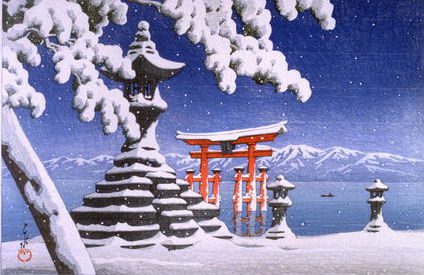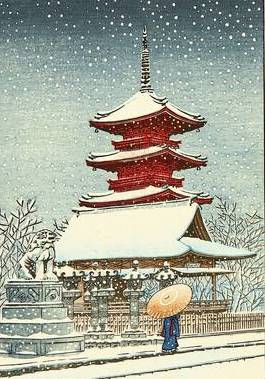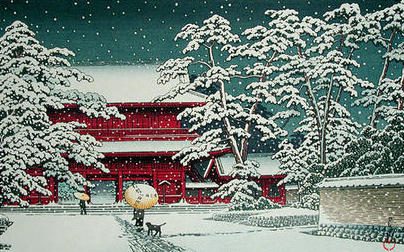Japan art and Kawase Hasui: Snow and spirituality
Lee Jay Walker
Modern Tokyo Times

Kawase Hasui (1883-1957) belongs to the world of Shin-Hanga (New Prints). In this art piece, following on from another similar theme, the spiritual angle of Buddhism and Shintoism fuses naturally with the falling snow.
In these art pieces, Hasui negates all the industrial and colonial convulsions that Japan witnessed after the Meiji Restoration of 1868 and continued during the early Showa Period. Instead, the serene angle of nature – and quietest Buddhism outside the War of Zen that encouraged militarism – is witnessed.

One can only imagine how Hasui viewed rapid modernization, the encroachment of Western art, communism, nationalism, militarism, socialism – and a host of social convulsions that altered Japan dramatically during his lifetime. Hence, it is nice to imagine Hasui enjoying the last winters of his life by visiting Buddhist temples and Shinto shrines – in the knowledge of peace and a new awakening.
The adorable fusion of nature and spirituality is a real treat. Indeed, the falling snow creates an already amazing scene that looks more magical concerning the contrast of colors, imagination and the coldness mixed with the warmth of spirituality.

The British Museum says, “Because of delicate health, which affected him all his life, he spent much time as a boy in the hot-spring resort of Shiobara where his aunt lived; his love of the Japanese landscape, and especially of scenes of snow, rain and mist, was born in those years... After the war, he was used by the Government to represent a gentler side of Japan in tourist publications, and in 1953 his ‘Zojoji in Snow’ was commissioned as an ‘Intangible Cultural Asset’ to represent the co-operative skills of the traditional print method.”
Overall, Hasui witnessed much throughout his life. Yet, through the prism of his art, you can envision a world not ruined by industrialization, nationalism, political ideology, war, and social convulsions. Therefore, it is fitting that in the post-war period, the government would utilize his serene art to spread soft power.

PLEASE DONATE TO HELP MODERN TOKYO TIMES
Modern Tokyo News is part of the Modern Tokyo Times group
DONATIONS to SUPPORT MODERN TOKYO TIMES – please pay PayPal and DONATE to sawakoart@gmail.com
http://moderntokyotimes.com Modern Tokyo Times – International News and Japan News
http://sawakoart.com – Sawako Utsumi personal website and Modern Tokyo Times artist
https://moderntokyonews.com Modern Tokyo News – Tokyo News and International News
PLEASE JOIN ON TWITTER
https://twitter.com/MTT_News Modern Tokyo Times
PLEASE JOIN ON FACEBOOK